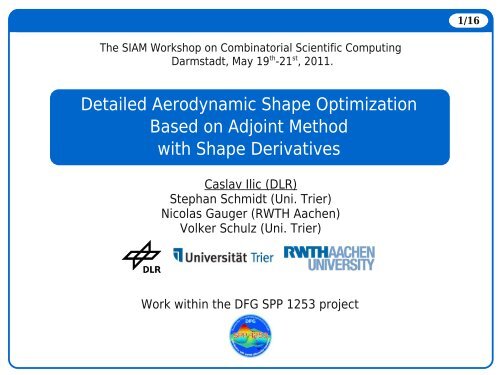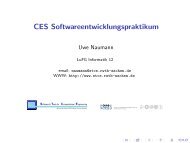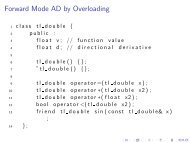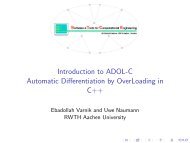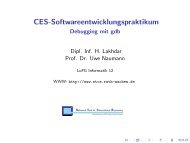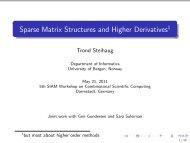Detailed Aerodynamic Shape Optimization Based on Adjoint Method ...
Detailed Aerodynamic Shape Optimization Based on Adjoint Method ...
Detailed Aerodynamic Shape Optimization Based on Adjoint Method ...
- No tags were found...
Create successful ePaper yourself
Turn your PDF publications into a flip-book with our unique Google optimized e-Paper software.
1/16The SIAM Workshop <strong>on</strong> Combinatorial Scientific ComputingDarmstadt, May 19 th -21 st , 2011.<str<strong>on</strong>g>Detailed</str<strong>on</strong>g> <str<strong>on</strong>g>Aerodynamic</str<strong>on</strong>g> <str<strong>on</strong>g>Shape</str<strong>on</strong>g> <str<strong>on</strong>g>Optimizati<strong>on</strong></str<strong>on</strong>g><str<strong>on</strong>g>Based</str<strong>on</strong>g> <strong>on</strong> <strong>Adjoint</strong> <strong>Method</strong>with <str<strong>on</strong>g>Shape</str<strong>on</strong>g> DerivativesCaslav Ilic (DLR)Stephan Schmidt (Uni. Trier)Nicolas Gauger (RWTH Aachen)Volker Schulz (Uni. Trier)Work within the DFG SPP 1253 project
Problem Scale in <str<strong>on</strong>g>Aerodynamic</str<strong>on</strong>g> <str<strong>on</strong>g>Optimizati<strong>on</strong></str<strong>on</strong>g>2/16➢Small scale● preliminary design phase● highly approximative models(algebraic, statistic)● key design parameters, oftendiscrete: O(10)● methods: EAs, simplex➢Medium scale● accurate models (CFD, CSM)● applicati<strong>on</strong>-driven globalparametrizati<strong>on</strong>: O(100)● methods: simplex, gradient
Problem Scale in <str<strong>on</strong>g>Aerodynamic</str<strong>on</strong>g> <str<strong>on</strong>g>Optimizati<strong>on</strong></str<strong>on</strong>g> (2)3/16➢Large scale● detailed design phase● accurate models (CFD, CSM)● “free” parametrizati<strong>on</strong>s: O(10 3 -10 5 ) design parameters● methods: adjoint-based gradient descent“free-form”“free-node”
<strong>Adjoint</strong>-<str<strong>on</strong>g>Based</str<strong>on</strong>g> Gradient Descent4/16➢C<strong>on</strong>strained gradient descent algorithms● Unc<strong>on</strong>strained (steepest gradient, BFGS...) with penalties● Sequential quadratic programming (SQP)● Interior-point (IP)➢Necessary: gradient of objective and c<strong>on</strong>straints● some Hessian informati<strong>on</strong> benefitial➢<strong>Adjoint</strong> formulati<strong>on</strong> for the gradient● computati<strong>on</strong> time theoretically independent of number ofdesign parameters● must solve adjoint (dual) state per objective/c<strong>on</strong>straint
<strong>Adjoint</strong>-<str<strong>on</strong>g>Based</str<strong>on</strong>g> Gradient Descent (2)5/16➢<str<strong>on</strong>g>Optimizati<strong>on</strong></str<strong>on</strong>g> time independent of number of designparameters hard to achieve in practice➢Need some combinati<strong>on</strong> of special ingredients...● Scalable parametrizati<strong>on</strong>s● movable surface mesh nodes (“free-node”)● knot-based parametric surfaces (c<strong>on</strong>trol mesh)What we did● Problem knowledge inside the optimizer (no “black-box”)● prec<strong>on</strong>diti<strong>on</strong>ing of the gradient descent● sufficient simulati<strong>on</strong> c<strong>on</strong>vergence (“<strong>on</strong>e-shot”)● No finite differences in gradient computati<strong>on</strong>● adjoining the whole tool-chain by AD● surface formulati<strong>on</strong> by shape derivatives
Test Case: Trans<strong>on</strong>ic Shock Removal6/16➢Remove shock from a wing; fixed planform, Euler flowAoA 3 deg, Mach 0.83initial Onera M6:unstructured mesh,3 levels (by adaptati<strong>on</strong>)lambda-shocklevel # points # elements # surf. nd.L1 110,000 580,000 18,000L2 290,000 1,590,000 36,000L3 820,000 4,660,000 72,000➢Objective: minimize drag➢C<strong>on</strong>straints:● preserve initial lift● preserve initial internal volume
Test Case: <str<strong>on</strong>g>Optimizati<strong>on</strong></str<strong>on</strong>g> Performance7/16optimal drag =induced drag (planform)+ spurious drag (numerics)optimaloptimizati<strong>on</strong> time =~7 x simulati<strong>on</strong> timeshock removed
Test Case: Secti<strong>on</strong> Pressure Distributi<strong>on</strong>8/16
Test Case: Secti<strong>on</strong> <str<strong>on</strong>g>Shape</str<strong>on</strong>g> Distributi<strong>on</strong>9/16
Surface Formulati<strong>on</strong> by Adjoining11/16➢Remove the expensive term by solving the adjoint problem● PDE and b.c. linearizati<strong>on</strong>● adjoining shape derivative● integrati<strong>on</strong> by partsarbitrary scalar field in Ω● substituti<strong>on</strong> of b.c.final deriv.surf. formset != 0adjoint b.c.set != 0adjoint PDE➢Details in PhD thesis by S. Schmidt, 2010.
Automatic Symbolic Derivati<strong>on</strong>12/16➢Manual adjoint shape derivati<strong>on</strong> tedious and error-pr<strong>on</strong>e, nophysical check-points for implementati<strong>on</strong>➢Do it automatically <strong>on</strong> the symbolic (c<strong>on</strong>tinuous) level● PDE, b.c., objectives, c<strong>on</strong>straints... → set of s-expressi<strong>on</strong>s● For each phase of manual adjoining, define● expressi<strong>on</strong> “finality” measure (=0 final, >0 not final)● expressi<strong>on</strong> “cost” measure (>0, the smaller the better)● set of expressi<strong>on</strong> transformers (recognizer-applicator)● For each phase, determine transformati<strong>on</strong> sequence whichreduces finality to zero, minimizes cost→ Combinatorial optimizati<strong>on</strong> problem?(Full enumerati<strong>on</strong> prohibitively expensive!)● C<strong>on</strong>vert final s-expressi<strong>on</strong> to target language (C, Fortran...)
Automatic Symbolic Derivati<strong>on</strong> (2)13/16➢Implementati<strong>on</strong> in Pyth<strong>on</strong>➢Example input, 2D stati<strong>on</strong>ary Euler flow problem:
Automatic Symbolic Derivati<strong>on</strong> (3)14/16➢Example derivati<strong>on</strong> phase, linerizati<strong>on</strong> of energy eq.● starting: finality = 3, cost = 5.6● linearized:finality = 0, cost = 160.4
C<strong>on</strong>clusi<strong>on</strong>: Practical Applicability?15/16➢Highly c<strong>on</strong>strained detailed design● rough c<strong>on</strong>straints (might prevent more optimal shapes)● how to transfer optimal shape back into a CAD model?➢“Advisory” optimizati<strong>on</strong>● free-node optimizati<strong>on</strong> starting from optimal shape fromapplicati<strong>on</strong>-fitted medium-scale parametrizati<strong>on</strong>● if gains useful, indicator to refine medium-scale parametrizati<strong>on</strong>➢Gradient by shape derivatives● if node sensitivities available, fast gradient computati<strong>on</strong> <strong>on</strong>arbitrary parametrizati<strong>on</strong> through chain rule
The End16/16Thank You ForYour Attenti<strong>on</strong>!


